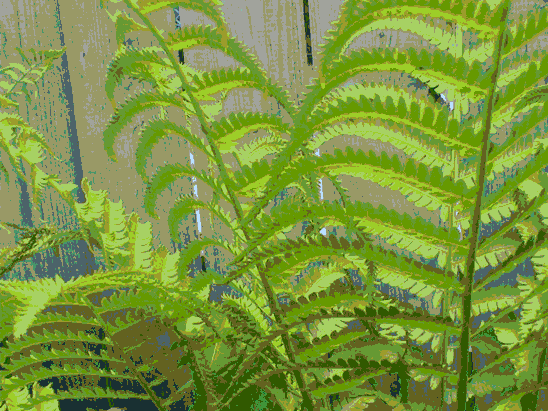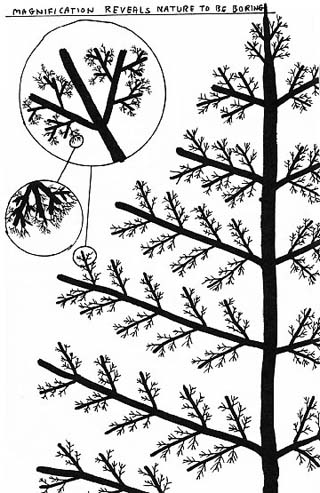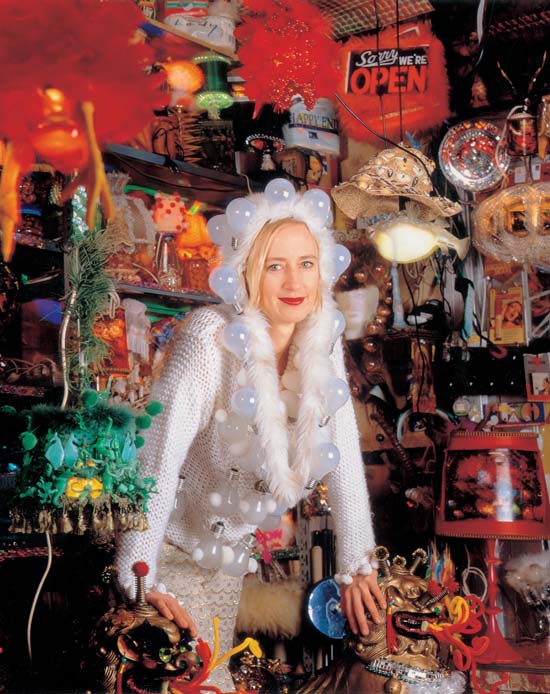
|
Lorna Mills and Sally McKay
Digital Media Tree this blog's archive OVVLvverk Lorna Mills: Artworks / Persona Volare / contact Sally McKay: GIFS / cv and contact |
View current page
...more recent posts

Who'd have thought art criticism was such a hot topic? The old-style stuff was moldy and dry, the new-style stuff is either glib and undemanding, or esoteric and niche. Interesting that so many of us (myself included) seem to care about it with some sort of passion. A few months ago this blog saw a glut of posts, spurred by a panel discussion in Toronto about whether or not criticism is irrelevant. A few days ago a really good post appeared at Iconoduel, a report on James Elkins' essay What Happened to Art Criticism? Iconoduel is a very interesting art blog from Chicago, written with insight and clarity by "Dan," who seems to have a cool and solid head on his shoulders. Read his post on Elkins (and then, like I'm thinking, you might not have to read Elkins!*).
" Ultimately, Elkins doesn't 'think it is necessarily a good idea to reform criticism: what counts is trying to understand the flight from judgment, and the attraction of description' (that is the appeal of descriptive criticism, so prevalent now, as opposed to the fiery polemics of a century ago)."*(I'm kidding but I'm not. Maybe part of the reason old guard art criticism has lost cachet is that we readers aren't sated by source material anymore. I rarely want to be absorbed into someone's rigid, worked-out thesis, I'd rather slide around in all the murky questions that rise off a work when others start to analyse and question it. It's partly an attention span thing, and a symptom of decadent culture-grazing, but it might also be a characteristic of rigorous post-modernism. One single point of view just doesn't cut it anymore.)
| Ivor Cutler: THE SUN The sun quietly withdraws its light from the bit of earth you are living on to give to the people who are just about to get up. But anyway, you are tired by then, so you just go to bed. FEEBLE TRY WITH A STONE #1 Why do I look at the stone -- draw it? Why do I stand apart? I shall speak to it. "Hello stone. How are you?" "Well I have a little pain at the back. It's the damp. A little moss gathering at the crack. Can you see it?" I bend. "Yes, I see," but do not offer advice. A cat is also talking to the stone about tinned food and the stone seems very interested. "Goodbye," I say. The cat and the stone turn and nod. "Come again soon," says the stone. What a bloody cheek! 'Come again soon!' A stone! In front of a cat! A TOUGH MARRIAGE There are words -- and there are thoughts. Try putting them together. Try clothing a thought with clear words to make it visible. If you are clever with words, the visibility will be facile. Watch the awkward person struggle for the right word, the honest word. Trust his integrity. | Dave Shrigley: |
My friend Von Bark, out of the blue, recently started quoting the Scottish wag and out-there poet/artist dude, Ivor Cutler. Thank you, friend! I'd forgotten all about Ivor Cutler and his crazy, sideways tug-at-your-heart stories, songs and bits of unclassifiable ephemera. Another friend, Sandra, lent me three wee books by Cutler, published in Scotland by the wee press, Arc Publications (the top left piece above, "The Sun," is from Is That Your Flap, Jack? and the two below it are from Fresh Carpet). If you do nothing else, follow this link to Ivor's Radio Sessions, with online audio samples. Scroll down to the mp3, "I ate a lady's bun," and listen to it. Then browse.
Checking in with Ivor Cutler again after all these years is timely, as another younger waggish Scottish bloke, Dave Shrigley, was all over Toronto's transit stops this spring with posters of his enigmatic nature/culture photographs that "walk softly" and poke pointed sticks at existential melancholy while evoking an "it's a damp cold" style of naturalism. Me and lots of other Canadians have been following Shrigley for years. His off-hand drawings, full of self-deprecation and foul abject humour strike a chord. Maybe I'm going too far to say that Canadians relate to Shrigley 'cause the stance of Scottish identity vis-a-vis England is so similar to us and USA? Yes likely... I am ...Dave Shrigley's career is doing fine all over the world, not just here. But I am excited to be finally putting Shrigley and Cutler together in the same sloppy zone of brain space inside my too-thick skull. Of course there is a lineage here, and how nice to finally grasp it.

Portrait Laura Kikauka, Funny Farm, 1999 © Foto: Constance Hanna/MAK
image taken from here.
In my non-blog life I spend time administering the manifestation of words onto pieces of paper, mass-produced and bound together as objects with trade value and three-D charisma. My own writing is also printed on paper from time to time. Recently, a profile I wrote about Allyson Mitchell (who I initially posted about here) was published in Canadian Art magazine. Allyson is a good and fun artist and it was easy to write. In the profile I said the following about Mitchell's studio:
"The space is an overstimulating jumble of toys, collectibles, plastic flowers, tiny artworks that look like knick-knacks, tiny knick-knacks that look like art, books, zines, cushions and personal belongings."
The Toronto-area art-use of macramé and googly-eyes belongs to a local history that must acknowledge Fastwurms, Lisa Neighbour, lots of other people, and most of all Laura Kikauka, who's awesome kitsch-power blows the rest of us wannabes out of the water. In her current installation at Toronto's Power Plant, far far too many interesting things are crammed into small spaces for our delectation. Kikauka has organised her gee-gaws with a remarkable amount of grace. By all rights, the sheer quantity of toys, packages, sequins, photographs, lampshades, shoes and wispy glue-gun trailings should be oppressive, but there is a lightness to Kikauka's touch that says, "Don't worry, it's okay! Just look at the parts you like and then be on your way, but if you want you're welcome to come back another day."
Michelle Allard's abstract sculpture, Extruded Expanded at YYZ* in Toronto is contemporary, eerie, and resonant. The material is crap: an industrial styrofoam that is presently used pretty much everywhere, a popular substance in this short phase of planet earth, this blink of an era in which humans swarm around building far too many things and messing with the chemistry of life itself. Front on, the sculpture looks something like a cityscape, a blank, abandoned, snowy icon of a cartoon post-apocalypse. The hard-edged shapes repeat, invoking fractals, crystals and other natural mechanisms. Together, their angled bulk is like a geological formation, a shifted tilted bed of rock that now juts up when it once lay flat. The cold blue flourescent light gives everything the cast of futuristic fiction and dispassionate display. All this from bits of styro-crap, cut and glued and left to tilt.
(Follow the link for a picture and Crystal Mowry's excellent essay. *And, yes I work there, but I'm in publishing not programming. Besides this is my blog and I'll write what I want.)

author's artist conception of audience appreciating audio
cyborg notes:
Janet Cardiff's 40 Piece Motet* made me think of old Star Trek episodes when Kirk would prove to some alien race that humans -- with their intermingled amibtion, passion, and technology -- are truly the most marvelous creatures. The idea behind the piece is simple: a recording of a choir performing Spem in Alium by Thomas Tallis in which each voice is a separate channel with a separate speaker, set at human-head height on an upright stand. All the speakers are in a wide circle around the perimeter of the room, so you can walk around slowly, listening to each person's contribution. You can stand in the middle of the room to get the full effect or you can pick a speaker/person (there's a tenor at the west end of the Power Plant installation that I particularly like) and hang out with them, following the thread of their part through the complex harmonies. Thomas Tallis (c1505-1585) wrote the piece for spatial effect, with the 40 voices divided into 8 separate choirs that might encircle the audience. I found Cardiff's incarnation of the work extremely moving; a marriage of physiology and technology that delivers an exquisite, complicated experience of beauty.
Other of Cardiff's major works demand a relinquishment of will on the part of the audience. They enforce submission to the artist's narrative environment and then, once you have given over, tease you in your disorientation. Paradise Institute requires you to line up for the opportunity to sit in a glorified crate and get spooked by the sounds in your headphones. The outdoor audio tours give you directives and play tricks on your mind, juggling the real versus recorded envrironments. Cardiff and partner George Bures Miller are brilliant with both sound technology and psychology, and the work is effectively invasive and transporting, the story unfolding right inside your head, just between the ears.
Being a control freak, I mightily resist this dynamic and resort to picking apart the narratives. The metaphors ring wrong, but this might simply be due to my recalcitrance. 40 Part Motet, however, is the exact opposite. It's art that lays there open, demanding nothing and offering a lot. Cardiff's extra stroke of brilliance was to record a rehearsal, rather than a performance, and to include a period of idle chit-chat before the singing starts. Two tenors discuss their inability to hit B-flat unless hungover, there is coughing, shuffling and general, gentle hubub. There is a pregnant moment of silence before the first note, the time when the choir turns focus on their work -- humans collecting themselves from the world and realigning as diaphragms, pipes, and air -- embodied here and delivered through electricity, cables, and finely-tuned machines.
(* the piece is on at The Power Plant in Toronto til September 6th)